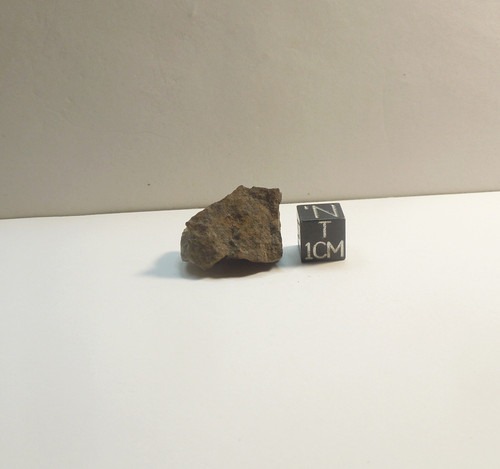Kapustin Yar was a Soviet-era "secret city" during the Cold War. It is home to the Kapustin Yar Rocket Range and is a key site in the Russian military industrial complex. It is where new missile technologies are tested and it is also the home to numerous UFO sightings by local residents. The frequency of UFO sightings has given the area the reputation as Russia's version of Roswell or Area 51.
In April of 2021, a Russian treasure hunter was looking for artifacts and scrap metal with a metal detector when he hit upon a large rock. Just a small portion of the rock was exposed and the rest was buried. He broke off a piece of the stone and took it to a friend who was a meteorite hunter. Upon seeing the sample, it was confirmed as a meteorite, and they went back to recover the massive rock. When it was finally excavated, the main mass weighed over 600 pounds, including a few pounds of fragments that had broken off.
The meteorite was eventually analyzed in a lab and classified as a L/LL6 type (the same type as Holbrook).
Refer to the photos. The black centimeter cube is shown for scale and is not included. You are purchasing a small fragment like the one shown. Your purchase will include a labeled gemjar for safe storage.
From the Meteoritical Bulletin entry on Kapustin Yar :
Kapustin Yar 48.806°N, 46.062°E
Astrakhanskaya oblast’, Russia
Find: April 2021
Classification: Ordinary chondrite (L/LL6)
History: Meteorite was found by a person from Volgograd city, which has been searching for antique coins and other metallic artifacts using a metal detector. Large stone was found April 2021 in the territory of former steppe khutor (farm) in Akhtubinskii district, northern Astrakhanskaya oblast’. This khutor is located nearby the Kapustin Yar rocket range and the boundary between the Astrakhanskaya and Volgogradskaya oblast’, 22 km southwest of the former settlement of Zhitkur (Volgogradskaya oblast’). The stone was partially exposed with the main part in the ground. He took a small sample and showed it to another prospector, who suggested it was a meteorite. On April 2023, they unearther the large stone and found additionally nine smaller fragments. Later one of fragments (approximately 500 g, 150 × 80 × 40 mm) was showed to Igor V. Karlov (Novosibirsk), who had hunted for the Tsarev chondrite near village Kolobovka (Volgogradskaya oblast’). Igor Karlov confirmed the meteotitic origin of the stone and purchased one fragment (201 g) for his own meteorite collection, and brought one sample (44.8 g) to pass it for study in SIGM (Novosibirsk).
Physical characteristics: Total mass is 276.5 kg (one large stone and nine small fragments). The large meteorite has angular and roughly rounded shape, size – 480 × 600 × 500 mm. Its surface is partially covered by fusion crust. Some small fragments also contain fusion crust. The interior is spotted and looks like a breccia, but both light and dark parts are similar in petrography and mineralogy, and the light part is more disintegrated than the dark one. The meteorite sample is slightly altered and halo of Fe-hydroxides is present around metal and sulfide grains.
Petrography: Classification - V.V. Sharygin (SIGM and UrFU) The meteorite contains a mid-grained to coarse recrystallized matrix and rare chondrules and their fragments. The chondrules (RP, POP, BO and PO species) are poorly defined; their sizes vary from 500 to 1000 µm. The chondrite matrix consists of olivine, low-Ca pyroxene, diopsidic clinopyroxene, albitic plagioclase, troilite, Fe-Ni-metal, chromite and accessory chlorapatite and merrillite. Metal-sulfide associations consist of kamacite, taenite, tetrataenite and troilite. Martensite occurs in some chondrules. Twinning occurs in some troilite grains. Plagioclase grains are larger than 50-100 µm. This outlines a petrological type of 6 for the meteorite. The metal abundance is about 3 vol%. The shock stage is low. Weathering grade is W2 with presence of Fe-hydroxides (mainly Ni-rich goethite) around some metal and troilite grains and in grain fissures. Pentlandite and rarely heazlewoodite are occasionally found in fissures in troilite.
Geochemistry: SEM-EDS analyses by V.V. Sharygin (SIGM and UrFU) The primary chondrite paragenesis includes olivine Fa26.37±0.42 (N=62), low-Ca pyroxene Fs22.32±0.59Wo1.55±0.34 (N=55), plagioclase Ab84.2An10.1Or5.7 (N=17), Cr-bearing clinopyroxene En45.2Fs8.4Wo46.4 (Cr2O3 – 0.7-0.9 wt.%, N=3), chromite Crt81.8Spl12.9 (N=17), chlorapatite, merrillite, FeNi-metals and troilite. Chlorapatite (N=9) contains F (0.5-0.9 wt.%), Cl (4.9-5.2 wt.%) and Na2O (0.4-0.5 wt.%). Merrillite is poor in FeO (up to 1.0 wt.%, N=4). Composition of metals (in wt.%): kamacite (N=14) – Fe 92.77±0.64, Ni – 6.09±0.51, Co – 1.16±0.23; taenite (N=7) – Fe 64.86±0.79, Ni 34.54±0.85, Co 0.53±0.12; tetrataenite (N=7) – Fe 45.75±2.68, Ni 53.89±2.61, Co 0.36±0.04; martensite (N=7) – Fe 83.26±0.35, Ni 15.55±0.30, Co 1.19±0.14. Compositions of the key silicates are intermediate between those in L and LL chondrites.
Classification: Ordinary chondrite L/LL6, S2, W2. Metal abundance and silicate composition is intermediate between that of L and LL groups. This meteorite is distinct from the Tsarev meteorite found 30-40 km away, both in mineral chemistry and texture.
Specimens: main mass - anonymous (Volgograd); 201 g – Igor V. Karlov (Novosibirsk); 44.8 g (two cut-off fragments – 34.6 and 10.2 g) – SIGM.





